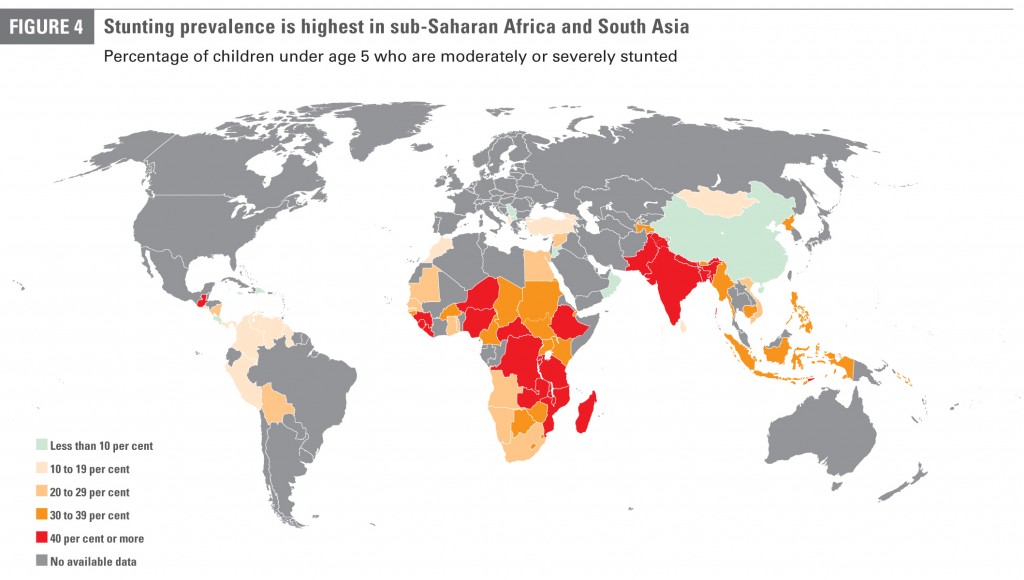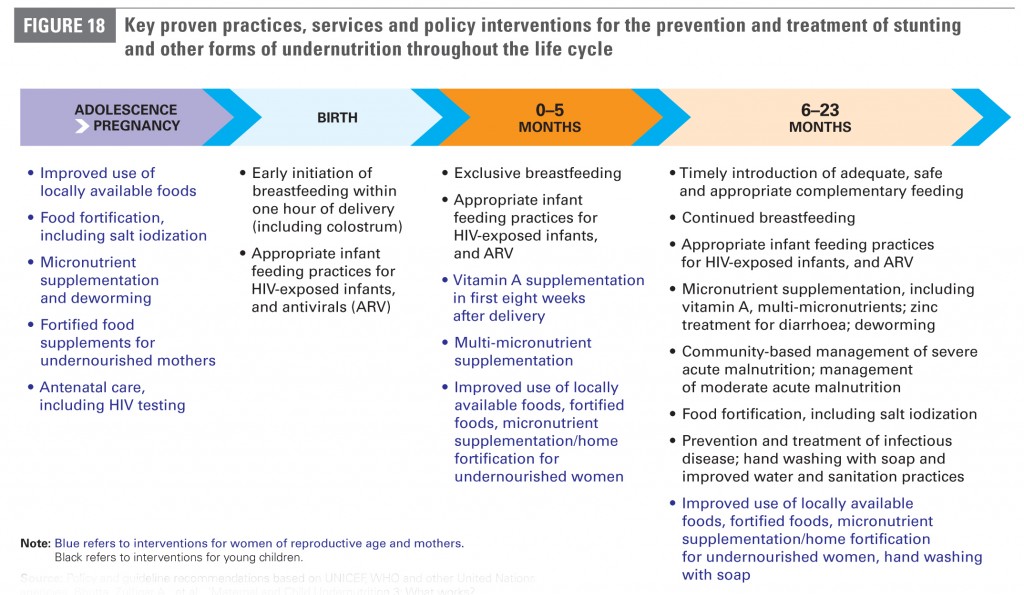Malnutrition – more complex than hunger
— World Food Programme
By Donna Shaver and Marcie Christensen
When we think of malnutrition, we may have images of rail-thin adults and stick-figure children with distended bellies, victims of famine and conflict. But according to the World Food Programme, these people represent only 8 percent of the world’s hunger victims. There are 870 million malnourished people in the world — all ages, rural and urban. Children, women, and people in rural areas are the most affected. And malnutrition is not just near starvation; it is much more complicated. While it is true that one form of malnutrition is lack of sufficient food to sustain life, there are other forms. The World Food Programme separates what is generally referred to as malnutrition into several categories:
- Under-nourishment is the term used to describe the status of people whose food intake does not include enough calories (energy) to meet minimum physiological needs for an active life. Most of the people affected are in developing countries.
- Malnutrition is characterized by inadequate intake of protein, energy, and micronutrients and by frequent infections and diseases. If people don’t have access to proper nutrition, they may die from common infections like measles or diarrhea. Malnutrition is measured by physical measurements of the body – weight or height – and age.
- Wasting is an indicator of acute malnutrition that reflects a recent and severe process that has led to substantial weight loss. This is usually the result of starvation and/or disease. Wasting can be temporary, where weight can be regained after illness. Chronic wasting is more disturbing
- Stunting is an important indicator of chronic malnutrition that reflects the long-term nutritional situation of a population. It is calculated by comparing the height-for-age of a child with a reference population of well-nourished and healthy children.
- Underweight is measured by comparing the weight-for-age of a child with a reference population of well-nourished and healthy children. An estimated 146 million children in developing countries are underweight.
- Obesity is the result of having plenty to eat, but the food is poor in nutrition and high in calories. Obesity is a growing problem in both the developed and the developing world. The Food and Agriculture Organization of the United Nations estimates that 1.4 billion people are overweight, 500 million of them are obese.
Types of Malnutrition
The World Food Programme also notes that there are several types of malnutrition, the most basic of which is called protein energy malnutrition. This is the type with which we are probably most familiar. The victim has major deficits in all major macronutrients such as carbohydrates, fats, and proteins.
Many other nutritional deficiencies are not obvious, but can be catastrophic – deficiencies in micronutrients such as vitamin A, iodine, iron, zinc, and folate. In 2009, a coalition of organizations — USAID, The World Bank, UNICEF, and three other organizations — issued a report on these micronutrients.
- Vitamin A boosts the immune system. Supplementation reduces mortality between ages six months and five years by an average of 23 percent. It is the most important factor in preventing childhood blindness, because lack of vitamin A is the primary cause of loss of sight in the five million visually disabled children.
- Iodine has a strong link to fetal cognitive development. When consumption of iodine in a community is sufficient, average IQ will be 13 points higher than in an iodine-deficient community.
- Iron is essential for the production of hemoglobin, which carries oxygen to the muscles and brain. It is critical for cognitive development in children and for the health of pregnant women and their fetuses.
- Zinc promotes immunity, resistance to infection, and nervous system development. Along with oral rehydration therapy, it contributes to reducing the incidence of diarrhea in children, the cause of 18 percent of deaths in children under five years of age.
- Folate is essential for healthy fetal development, so it is especially important that pregnant women have sufficient levels prior to conception.
Nutrition during Pregnancy
The health of the child starts with conception, and is inextricably intertwined with the health of the mother. In 2013, the British medical journal, The Lancet, published a series of papers titled Maternal and Child Nutrition. Key findings include:
- Iron and calcium deficiencies contribute substantially to maternal deaths.
- Maternal iron deficiency is associated with babies with low weight (less than 5 lbs. 8 oz.) at birth.
- Maternal and child under-nutrition and non-stimulating household environments contribute to deficits in children’s development, health and productivity in adulthood.
- Maternal overweight and obesity are associated with maternal morbidity, preterm birth and increased infant mortality.
- Under-nutrition, including fetal growth restriction, suboptimum breastfeeding, stunting, wasting and deficiencies of vitamin A and zinc, cause 45 percent of child deaths, resulting in 3.1 million deaths annually.
- Prevalence of overweight and obesity is increasing in children younger than five years globally and is an important contributor to diabetes and other chronic diseases in adulthood.
- Under-nutrition during pregnancy, affecting fetal growth and the first two years of life, is a major determinant of both stunting of height and subsequent obesity and non-communicable diseases in adulthood.
Causes of Hunger
- Poverty: People in poverty can’t afford nutritious food, making them less able to work for money to buy nutritious food, and the cycle continues.
- Lack of Investment by developing countries in agricultural infrastructure such as roads, warehouses, irrigation—plus investments in improving land management.
- Climate & weather: Drought is one of most common causes of food shortages
- War & displacement: Sometimes food becomes a weapon. During conflict, soldiers will often starve their opponents by destroying livestock and damaging water sources.
- Unstable markets: When food prices rise, consumers often have to shift to lower-priced, less nutritious options.
- Food waste: One third of all food produced (1.3 billion tons) is never consumed. (Paul West of the University of Minnesota-St. Paul and his team have determined that improving farming practices, mostly in Africa, Asia and Eastern Europe, could feed another 850 million people. Africa alone accounts for nearly half of those potential gains.)
— World Food Programme

Poor maternal health contributes to the problem. Increasingly, attention is focused on sanitation. Dean Spears, an economist at the Delhi School of Economics, believes that the answer lies in open defecation. Excrement gets into groundwater, on the soil, on crops in the field, and in rivers that supply drinking water. As UNICEF notes, one gram of feces can contain 10,000,000 viruses, 1,000,000 bacteria, 1,000 parasite cysts, and 100 parasite eggs.
India’s sanitation is among the worst in the world, which explains why wealthy children as well as poor children experience stunting. Children of all economic classes are repeatedly sickened by exposure to unsanitary conditions. As Jean Humphrey, professor of human nutrition at Johns Hopkins Bloomberg School of Public Health, explains, “These children’s bodies divert energy and nutrients away from growth and brain development to prioritize infection-fighting survival.”
A large obstacle to improved sanitation is the challenge of convincing the millions who practice open defecation to adopt the use of toilets. In a sample of 3,200 rural households that have been supplied with a government latrine in India’s five poorest states, the majority refused to use it. Many people believe that using the latrines is unsanitary. “The problem is that germs are invisible, and so understanding the threat of open defecation is far removed from reality until they are sick and dying. And even then, they don’t really understand”, says Archana Patkar, program manager at the Water Supply & Sanitation Collaborative Council in Geneva
Some good news
From Rwanda – Dining for Women’s Featured Program for November 2014 is Gardens for Health International. Gardens for Health works in partnership with government-run health centers to integrate agricultural support with health and nutrition education into the treatment of malnutrition. The organization has have worked with over 1,900 families, helping to ensure that 7,600 children have the healthy food they need to grow and thrive.
Their work is having a measurable impact on the families they serve: one year after enrolling in the program, 71% of children are at a healthy weight.
From India – In 2013, UNICEF launched an attention-getting campaign to improve sanitation, since studies made evident the link between open defecation and malnutrition. Aimed at young people, the theme is “Take Poo to the Loo”. The website features cartoon videos, facts about the health threat of open defecation, catchy songs, health and hygiene information, and more. The language is bold and descriptive. There is also a “Take Poo to the Loo” Facebook page.
From Tanzania – Vitamin A supplementation among children aged six months to five years was introduced in 2001 and more than 90 percent of children have received twice-yearly supplements. This coverage has been cited as one of the key factors in the country’s declining rate of child mortality – from 126 deaths per 1,000 live births in 2000 to 68 deaths per 1,000 in 2011.
Strategies to Prevent Stunting and Malnutrition
Many countries are taking action to alleviate malnutrition and reduce stunting, from direct actions during the 1,000 days covering pregnancy and the child’s first two years, to nutrition-sensitive approaches to sanitation and land-use practices. You can read many success stories in the 2013 UNICEF report, Improving Child Nutrition (a 127 page report available in PDF).
There are also new developments in global partnerships that address malnutrition, including
- Scaling Up Nutrition (The SUN Movement), involving more than 30 countries, UN Organizations, civil society and the private sector to increase access to resources and improve coordination of nutrition services.
- Renewed Efforts Against Child Hunger and Under-nutrition (REACH) – a commitment by the World Food Programme, UNICEF, the Food and Agriculture Organization of the United Nations, and the World Health Organization to coordinate multiple agencies and governments as they design policies and programs to address malnutrition.



